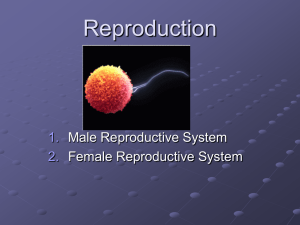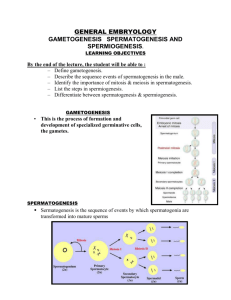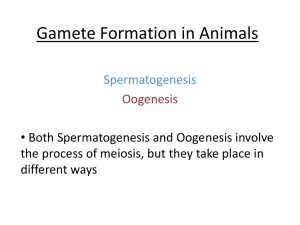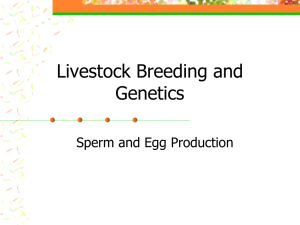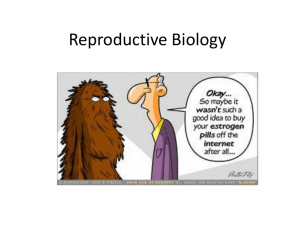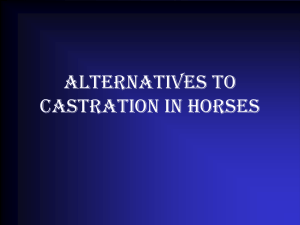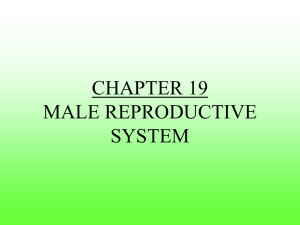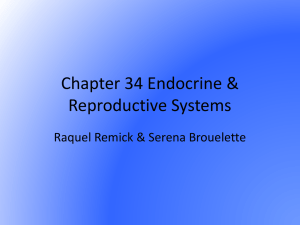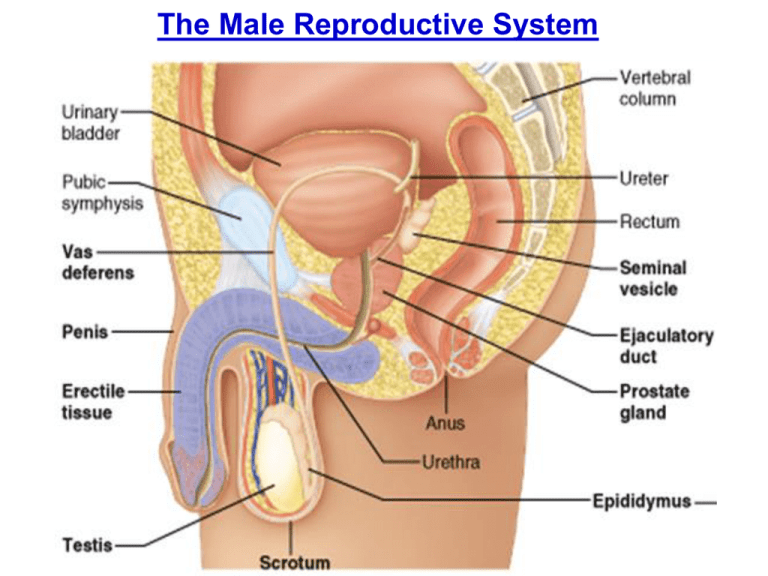
The Male Reproductive System
Epididymis
The Testes (male gonads - Primary sex organs)
Produce sperms
Produce sex hormones
Found in a sac called the scrotum
Suspended outside of the body cavity for temperature
reduction
Testes wall made of fibrous connective tissue
(Divides the testes into lobules (Chambers)
Inside the chambers are long tubules (70 cm) called
the Seminiferous tubules,this is the actual site for
spermatogenesis (manufacturing sperms).
Interstitial cells secrete androgens “testosterone”
Diagram of a Testis
Spermatogenesis –Sperm Development
http://highered.mcgraw-hill.com/novella/MixQuizProcessingServlet
• Sperms cells are derived from undifferentiated cells
called SPERMATOGONIA (sing. Spermatogonium),
which lie just on the inside wall of a tubule and divide
mitotically, always producing new spermatogonia.
• Some newly formed spermatogonia move away from
the wall to increase in size and become primary
spermatocytes, which divide by meiosis I (reduction
division) to give 2 secondary spermatocytes, each
with 23 chromosomes.
• Secondary spermatocytes divide by meiosis II to
produce 4 spermatids, also with 23 chromosomes, but
each only having one chromatid.
https://highered.mcgraw-hill.com/sites/0072495855/student_view0/chapter28/animation__how_meiosis_works.html
• Spermatids then differentiate into sperms (spermatozoa)
• Also present in the tubules are the Sertoli cells, which
support, nourish and regulate the spermatogenic
cells.
The Seminiferous Tubule
The Seminiferous Tubule
What is the main function of Spermatogonia?
To produce sperms
What is the main function of Sertoli cells?
To provide nurishment for the spermatids
(maturing sperms)
Secrete inhibin to inhibit the production of
FSH
What is the main function of the interstitial
cells of Leydig?
To produce androgens (Testosterone)
Epididymus
o Stores sperm as they mature
Seminal Vesicles
o 65% of seminal fluid, fructose rich to provide energy to sperms.
Cowper’s Gland (aka: Bulbourethral gland)
o Pea-sized organs, lie posterior to the prostate on either sides
of the urethra, produces alkaline fluid to neutralize urethral
urine.
o Contributes to seminal fluid (2%)
Prostate Gland
o A single dough-nut shaped gland that surrounds the upper
portion of the urethra just below the bladder.
o Produce prostaglandins (hormones that cause the contractions
of the vagina to help move sperms)
Urethra
o Conducts sperm out of the body
Ductus Vas Deferens
o Conducts and stores sperms
Penis
o Serves as an organ of copulation (sexual
intercourse)
Name the structure that is a common path for
urine and semen?
The Urethra
Which structure functions as a storage and
maturation site for sperms?
The epididymis
Name the acessory glands of the male
reproductive system?
The seminal vesicles (a pair)
The bulbourethral (aka: Cowper's gl.) (a pair)
The prostate (single doughnut shaped)
Path of Sperms
1. Formed in the seminiferous tubules of the
testes
2. Mature and store in the epididymus
3. Store in the Vas Deferens as well
4. Enter the urethra just prior to ejaculation
5. Accessory glands (prostate, Cowper’s gland,
and seminal vesicle) add secretions to semen.
6. Semen including sperms exit through the
penis.
Put the following structures in the appropriate order
according to the path of sperms:
Urethra
Ductus deferens
1
.
2
.
3
.
4
.
Epididymis
Seminiferous tubules
Seminal Fluid
SOURCES:
1. Seminal Vesicle
2. Prostate Gland
3. Cowper’s Gland
Semen composition
Seminal Fluid Functions:
1. Produce slightly basic pH 7.5 preferred pH of
sperm (Basic) to counteract the acidity level of
the vagina.
2. Provides fructose for energy for sperm
3. Contains prostaglandins – chemicals which
cause the uterus to contract.
4. Aids in the movement of the sperm towards
the egg.
5. Lubrication
Sperm Parts
Head:
o 23 chromosomes
o Acrosome attached- type of Lysosome
- Attached to nucleus
- Contains hydrolytic enzymes
- Digests a hole in outer layer of egg so sperm can
penetrate.
Middle Piece:
o Contains mitochondria – for energy
Tail (Flagellum):
o 9 + 2 microtubules arrangement – Used for
locomotion
Most flagella, like
cilia, have a
characteristic “9+2”
microtubule
structure, i.e., two
central singlet
microtubules are
encircled by nine
outer doublet
microtubules.
1.
Spermatogenesis occurs in the
A) epididymis.
B) seminiferous tubules.
C) prostate gland.
D) vas deferens.
E) seminal vesicle.
2. Which of the following is a correct sequence of cells in
spermatogenesis?
A) spermatogonium -> primary spermatocyte ->
secondary spermatocyte
B) spermatogonium -> secondary spermatocyte ->
primary spermatocyte
C) primary spermatocyte -> secondary spermatocyte
-> spermatogonium
D) primary spermatocyte -> spermatogonium ->
secondary spermatocyte
E) none of the above
3.During spermatogenesis, which of the following
cells is the first to become haploid?
A) primary spermatocyte
B) secondary spermatocyte
C) sperm cells
D) spermatid
E) spermatogonium
4.Meiosis II of spermatogenesis results in the
formation of secondary spermatocytes.
A) True
B) False
5.During spermatogenesis, spermatids
differentiate into spermatozoa.
...
A) True
B) False
The correct answer for each question is indicated by a This is the correct answer..
1
2
3
4
5
Spermatogenesis occurs in the
A)
epididymis.
B)
seminiferous tubules. This is the correct answer.
C)
prostate gland.
D)
vas deferens.
E)
seminal vesicle.
Which of the following is a correct sequence of cells in spermatogenesis?
A)
spermatogonium -> primary spermatocyte -> secondary spermatocyte This is the correct answer.
B)
spermatogonium -> secondary spermatocyte -> primary spermatocyte
C)
primary spermatocyte -> secondary spermatocyte -> spermatogonium
D)
primary spermatocyte -> spermatogonium -> secondary spermatocyte
E)
none of the above
During spermatogenesis, which of the following cells is the first to become haploid?
A)
primary spermatocyte
B)
secondary spermatocyte This is the correct answer.
C)
sperm cells
D)
spermatid
E)
spermatogonium
Meiosis II of spermatogenesis results in the formation of secondary spermatocytes.
A)
True
B)
False
This is the correct answer.
During spermatogenesis, spermatids differentiate into spermatozoa.
A)
True
B)
False
This is the correct answer.
Functions of Testosterone
1. Essential for development of primary sex organs.
2. Essential for the development of sperms
- Spermatogenic cells take up testosterone which stimulate
their activity.
3. Increase testosterone concentration at puberty causes
maturation of Penis and testes.
4. Secondary Sex Characteristics
o facial hair
o larynx expands (voice changes)
o armpit hair
o Increase muscular strength
o pubic hair
o aggression
o oil and sweat glands secretions (=Stink)
o sex drive
NOTE: Side effect is baldness if genetically predisposed.
Hormonal Control of Testosterone
Hypothalamus releases GnRH
(Gonadotropic releasing hormone)
GnRH causes anterior pituitary to
release 2 gonadotropic hormones:
o FSH (Follicle stimulating hormone)
- Promotes spermatogenesis in
the siminiferous tubules
o LH (Leutenizing Hormone)
- Promotes production of
testosterone in interstitial cells.
Hormonal Control of Testosterone
NEGATIVE FEEDBACK
o Increase testosterone concentration
in the blood causes the anterior pituitary
to make less LH, therefore less
testosterone is produced.
o Decrease testosterone concentration
in the blood causes the anterior
pituitary to make more LH and therefore
more testosterone is produced.
o Increase concentration of stored
sperm causes an increase in production
of inhibin (from Sertoli cells) and
decreases production of FSH, therefore
production of sperm decreases.
o Decrease concentration of stored
sperm causes a decrease in production
of inhibin and more FSH, therefore
more sperm is produced.

